instrument panel TOYOTA YARIS 2020 Owners Manual
[x] Cancel search | Manufacturer: TOYOTA, Model Year: 2020, Model line: YARIS, Model: TOYOTA YARIS 2020Pages: 692, PDF Size: 68.71 MB
Page 16 of 692

16Pictorial index
YARIS_F_OM_Europe_OM52A54E
■Instrument panel (Left-hand drive vehicles)
Engine switch . . . . . . . . . . . . . . . . . . . . . . . . . . . . . . . . P. 241, 243
Starting the engine . . . . . . . . . . . . . . . . . . . . . . . . . . . . . P. 241, 243
Changing engine switch positions/modes . . . . . . . . . . . . P. 241, 245
Emergency stop of the engine . . . . . . . . . . . . . . . . . . . . . . . . . P. 569
When the engine will not start . . . . . . . . . . . . . . . . . . . . . . . . . P. 629
Warning lights*1, 2/warning messages*1, 3. . . . . . . . . . . P. 590, 592
Shift lever . . . . . . . . . . . . . . . . . . . . . . . . . . . . . . . . . . . . P. 252, 260
Changing the shift position . . . . . . . . . . . . . . . . . . . . . . . P. 252, 260
Precautions against towing . . . . . . . . . . . . . . . . . . . . . . . . . . . P. 572
When the shift lever does not move*4. . . . . . . . . . . . . . . . . . . P. 257
Meters . . . . . . . . . . . . . . . . . . . . . . . . . . . . . . . . . . . . . . . P. 115, 118
Reading the meters . . . . . . . . . . . . . . . . . . . . . . . . . . . . . .P. 115, 118
Adjusting the instrument cluster light . . . . . . . . . . . . . . . . P. 116, 120
Warning lights/indicators . . . . . . . . . . . . . . . . . . . . . . . . . . . . . P. 108
When the warning lights come on . . . . . . . . . . . . . . . . . . . . . . P. 581
1
2
3
Page 24 of 692
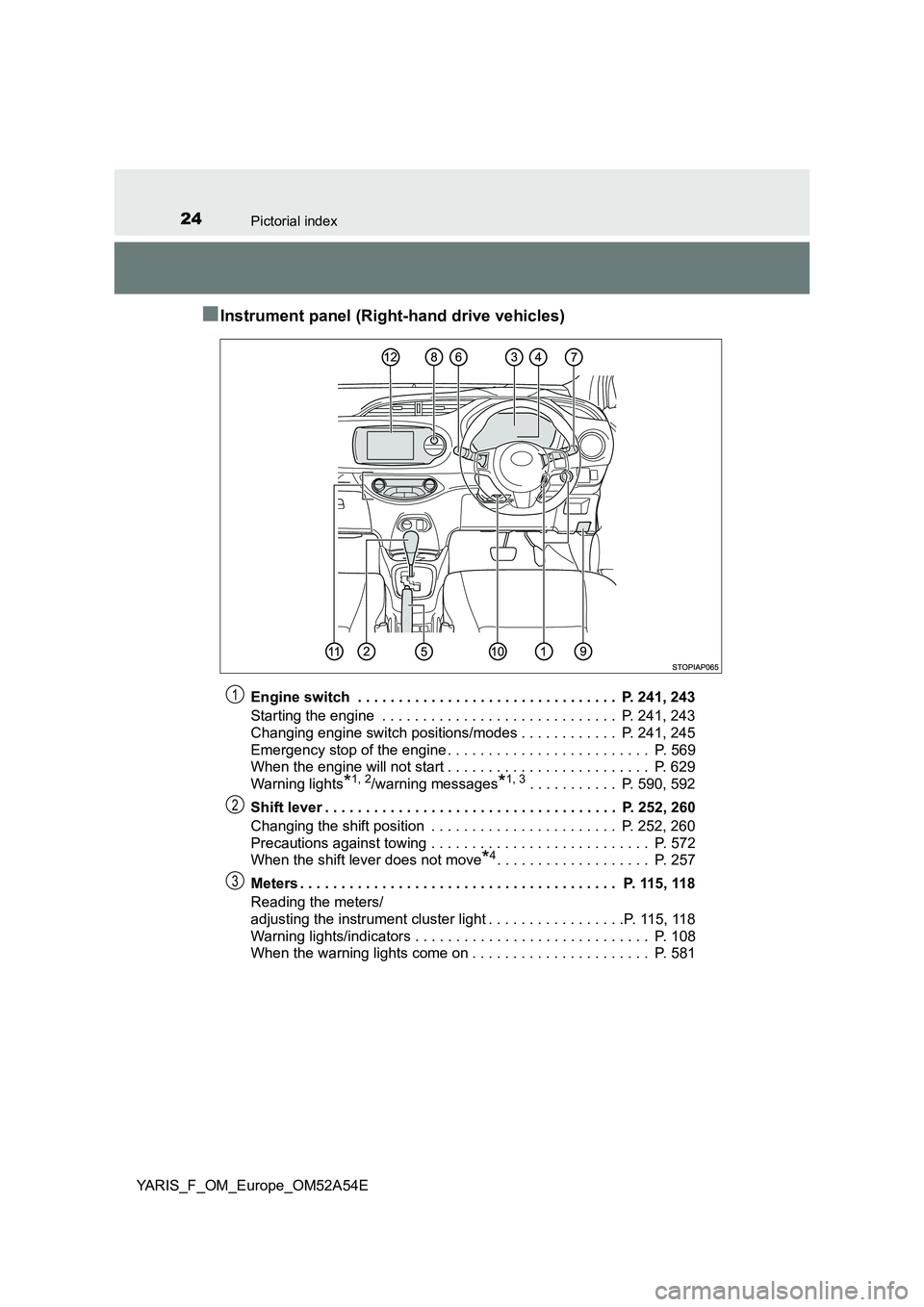
24Pictorial index
YARIS_F_OM_Europe_OM52A54E
■Instrument panel (Right-hand drive vehicles)
Engine switch . . . . . . . . . . . . . . . . . . . . . . . . . . . . . . . . P. 241, 243
Starting the engine . . . . . . . . . . . . . . . . . . . . . . . . . . . . . P. 241, 243
Changing engine switch positions/modes . . . . . . . . . . . . P. 241, 245
Emergency stop of the engine . . . . . . . . . . . . . . . . . . . . . . . . . P. 569
When the engine will not start . . . . . . . . . . . . . . . . . . . . . . . . . P. 629
Warning lights*1, 2/warning messages*1, 3. . . . . . . . . . . P. 590, 592
Shift lever . . . . . . . . . . . . . . . . . . . . . . . . . . . . . . . . . . . . P. 252, 260
Changing the shift position . . . . . . . . . . . . . . . . . . . . . . . P. 252, 260
Precautions against towing . . . . . . . . . . . . . . . . . . . . . . . . . . . P. 572
When the shift lever does not move*4. . . . . . . . . . . . . . . . . . . P. 257
Meters . . . . . . . . . . . . . . . . . . . . . . . . . . . . . . . . . . . . . . . P. 115, 118
Reading the meters/
adjusting the instrument cluster light . . . . . . . . . . . . . . . . .P. 115, 118
Warning lights/indicators . . . . . . . . . . . . . . . . . . . . . . . . . . . . . P. 108
When the warning lights come on . . . . . . . . . . . . . . . . . . . . . . P. 581
1
2
3
Page 49 of 692
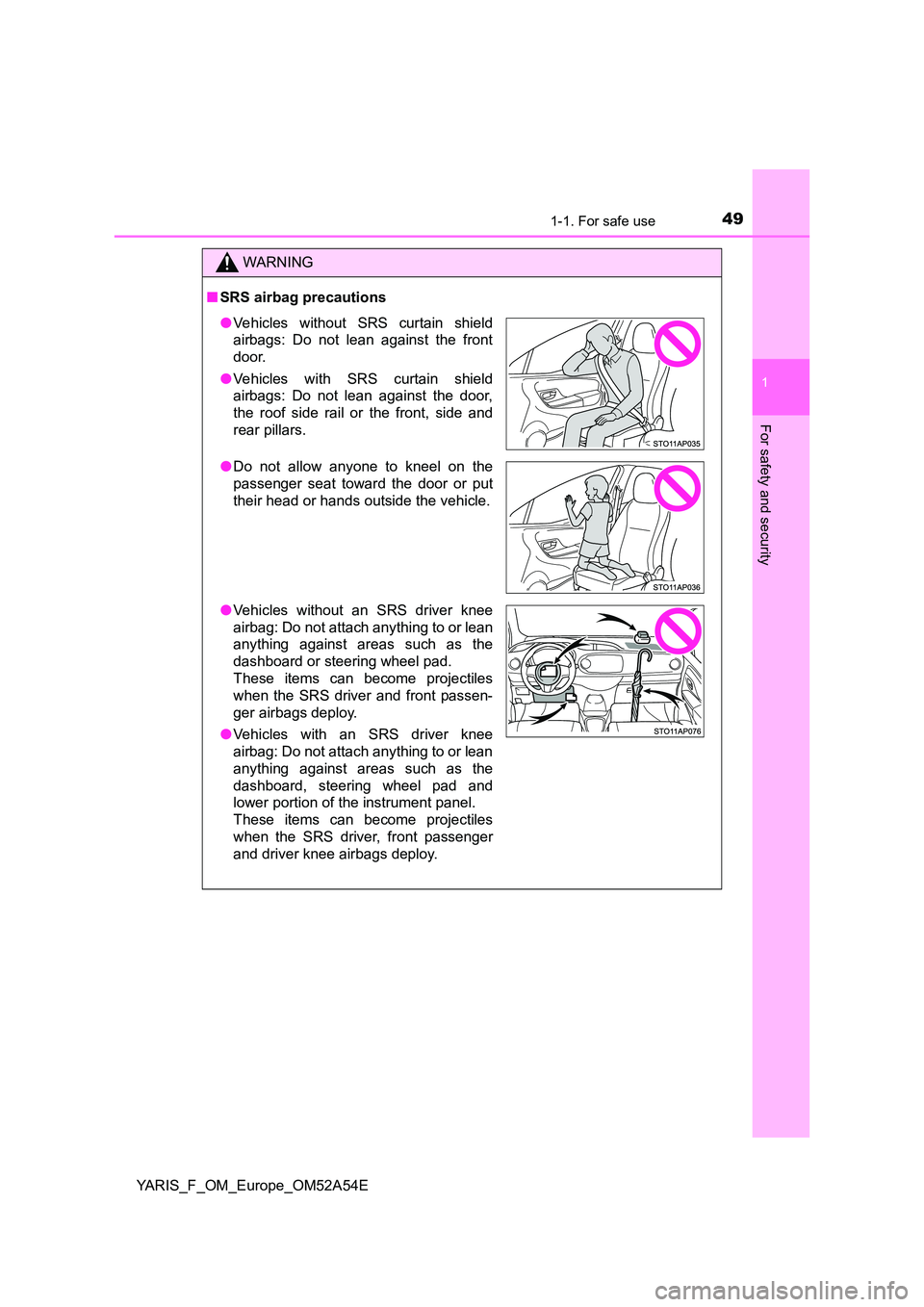
491-1. For safe use
1
For safety and security
YARIS_F_OM_Europe_OM52A54E
WARNING
■SRS airbag precautions
●Vehicles without SRS curtain shield
airbags: Do not lean against the front
door.
● Vehicles with SRS curtain shield
airbags: Do not lean against the door,
the roof side rail or the front, side and
rear pillars.
● Do not allow anyone to kneel on the
passenger seat toward the door or put
their head or hands outside the vehicle.
● Vehicles without an SRS driver knee
airbag: Do not attach anything to or lean
anything against areas such as the
dashboard or steering wheel pad.
These items can become projectiles
when the SRS driver and front passen-
ger airbags deploy.
● Vehicles with an SRS driver knee
airbag: Do not attach anything to or lean
anything against areas such as the
dashboard, steering wheel pad and
lower portion of the instrument panel.
These items can become projectiles
when the SRS driver, front passenger
and driver knee airbags deploy.
Page 51 of 692
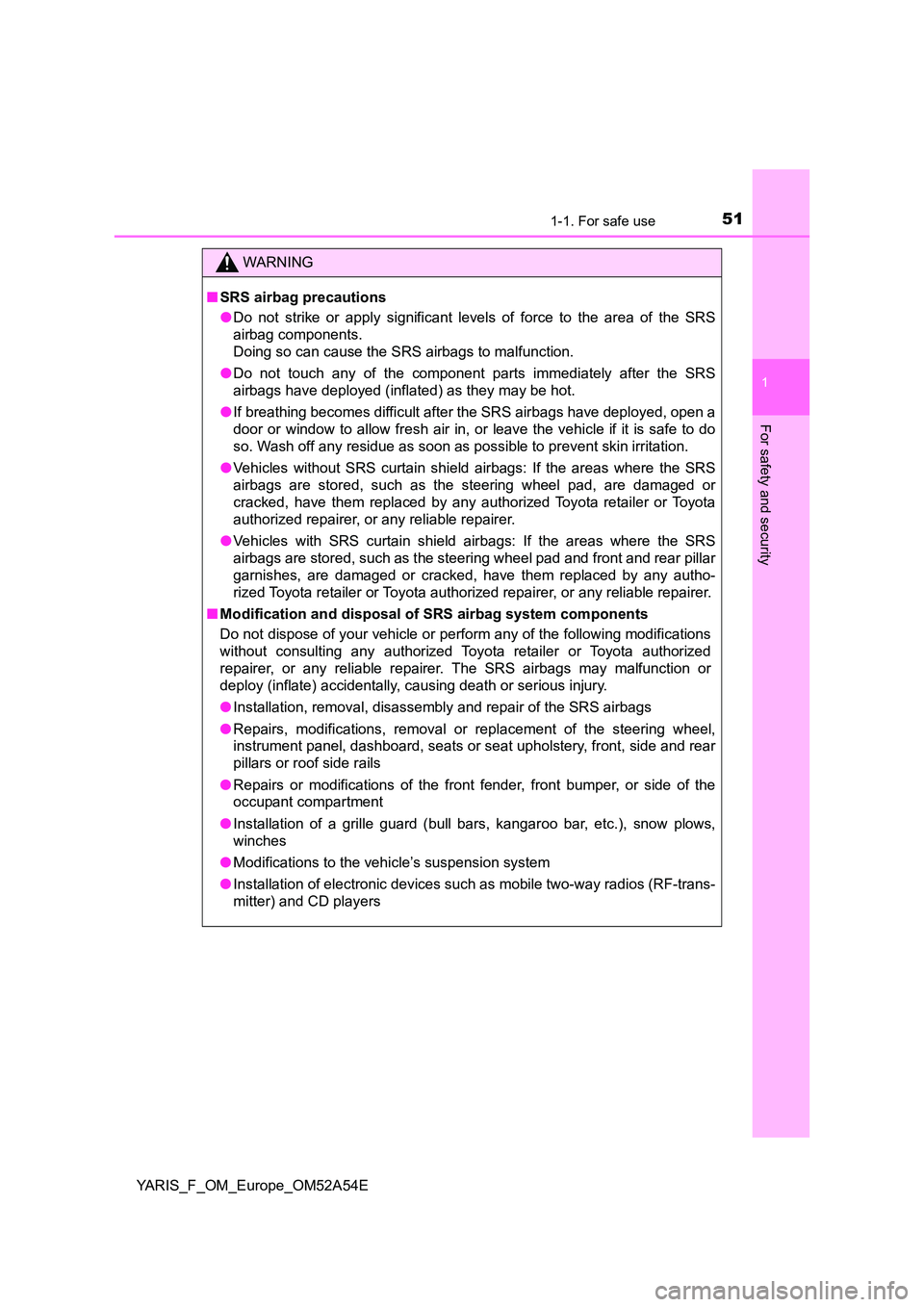
511-1. For safe use
1
For safety and security
YARIS_F_OM_Europe_OM52A54E
WARNING
■SRS airbag precautions
● Do not strike or apply significant levels of force to the area of the SRS
airbag components.
Doing so can cause the SRS airbags to malfunction.
● Do not touch any of the component parts immediately after the SRS
airbags have deployed (inflated) as they may be hot.
● If breathing becomes difficult after the SRS airbags have deployed, open a
door or window to allow fresh air in, or leave the vehicle if it is safe to do
so. Wash off any residue as soon as possible to prevent skin irritation.
● Vehicles without SRS curtain shield airbags: If the areas where the SRS
airbags are stored, such as the steering wheel pad, are damaged or
cracked, have them replaced by any authorized Toyota retailer or Toyota
authorized repairer, or any reliable repairer.
● Vehicles with SRS curtain shield airbags: If the areas where the SRS
airbags are stored, such as the steering wheel pad and front and rear pillar
garnishes, are damaged or cracked, have them replaced by any autho-
rized Toyota retailer or Toyota authorized repairer, or any reliable repairer.
■ Modification and disposal of SRS airbag system components
Do not dispose of your vehicle or perform any of the following modifications
without consulting any authorized Toyota retailer or Toyota authorized
repairer, or any reliable repairer. The SRS airbags may malfunction or
deploy (inflate) accidentally, causing death or serious injury.
● Installation, removal, disassembly and repair of the SRS airbags
● Repairs, modifications, removal or replacement of the steering wheel,
instrument panel, dashboard, seats or seat upholstery, front, side and rear
pillars or roof side rails
● Repairs or modifications of the front fender, front bumper, or side of the
occupant compartment
● Installation of a grille guard (bull bars, kangaroo bar, etc.), snow plows,
winches
● Modifications to the vehicle’s suspension system
● Installation of electronic devices such as mobile two-way radios (RF-trans-
mitter) and CD players
Page 55 of 692

551-1. For safe use
1
For safety and security
YARIS_F_OM_Europe_OM52A54E
■ When to contact any authorized Toyota retailer or Toyota authorized
repairer, or any reliable repairer
In the following cases, the vehicle will require inspection and/or repair. Con-
tact any authorized Toyota retailer or Toyota authorized repairer, or any reli-
able repairer as soon as possible.
● Any of the SRS airbags have been inflated.
● The front of the vehicle is damaged or
deformed, or was involved in an acci-
dent that was not severe enough to
cause the SRS front airbags to inflate.
● A portion of a door or its surrounding
area is damaged or deformed, or the
vehicle was involved in an accident that
was not severe enough to cause the
SRS side airbags and SRS curtain
shield airbags (if equipped) to inflate.
● Vehicles without an SRS driver knee
airbag: The pad section of the steering
wheel or dashboard near the front pas-
senger airbag is scratched, cracked, or
otherwise damaged.
● Vehicles with an SRS driver knee airbag:
The pad section of the steering wheel,
dashboard near the front passenger
airbag or lower portion of the instrument
panel is scratched, cracked, or other-
wise damaged.
Page 108 of 692
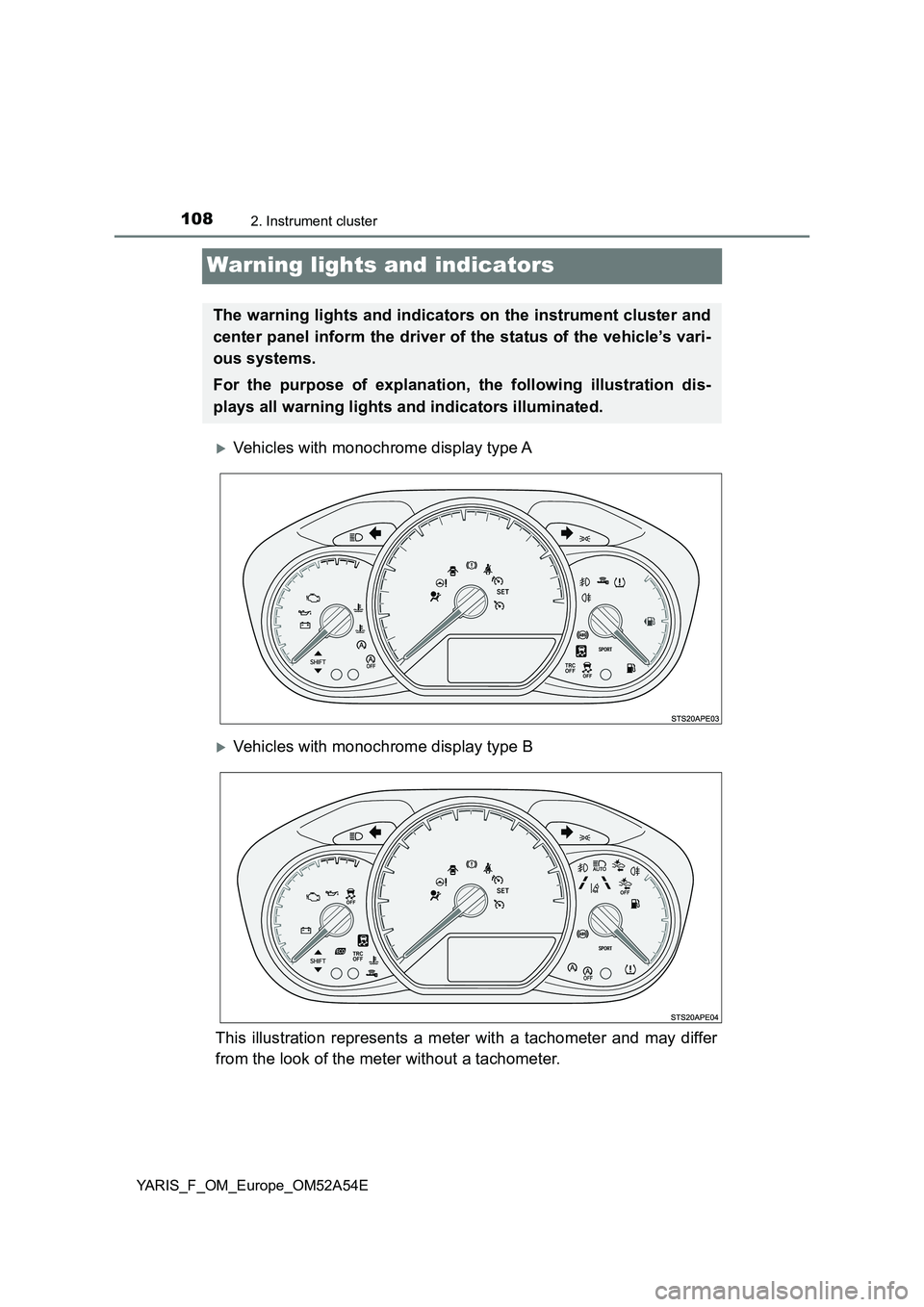
1082. Instrument cluster
YARIS_F_OM_Europe_OM52A54E
Warning lights and indicators
Vehicles with monochrome display type A
Vehicles with monochrome display type B
This illustration represents a meter with a tachometer and may differ
from the look of the meter without a tachometer.
The warning lights and indicators on the instrument cluster and
center panel inform the driver of the status of the vehicle’s vari-
ous systems.
For the purpose of explanation, the following illustration dis-
plays all warning lights and indicators illuminated.
Page 111 of 692

1112. Instrument cluster
2
Instrument cluster
YARIS_F_OM_Europe_OM52A54E
*1: These lights turn on when the engine switch is turned to the “ON” position
(vehicles without a smart entry & start system) or IGNITION ON mode
(vehicles with a smart entry & start system) to indicate that a system check
is being performed. They will turn off after the engine is started, or after a
few seconds. There may be a malfunction in a system if a light does not
come on, or if the lights do not turn off. Have the vehicle inspected by any
authorized Toyota retailer or Toyota authorized repairer, or any reliable
repairer.
*2: If equipped
*3: The light flashes in yellow to indicate a malfunction. The light flashes
quickly in green to indicate that the steering lock has not been released.
*4: The light turns on to indicate a malfunction.
*5: The light flashes to indicate a malfunction.
*6: The light illuminate on the center panel.
*7: The lights turn on with LDA indicator to indicate a malfunction.
*8: Vehicles with monochrome display.
*9: Vehicles with color display.
*10: The light illuminates on the multi-information display.
*8
Open door warning light
(P. 584)*2, 6Rear passengers’ seat
belt reminder lights
(P. 585)
Low fuel level warning
light (P. 585)*1, 2Tire pressure warning
light (P. 585)
Driver’s and front pas-
senger’s seat belt
reminder light (P. 585)*1, 9
Master warning light
(P. 585)
Page 113 of 692

1132. Instrument cluster
2
Instrument cluster
YARIS_F_OM_Europe_OM52A54E
*1: Vehicles without a smart entry & start system:
These lights turn on when the engine switch is turned to the “ON” position
to indicate that a system check is being performed. They will turn off after
the engine is started, or after a few seconds. There may be a malfunction
in a system if a light does not come on, or if the lights do not turn off. Have
the vehicle inspected by any authorized Toyota retailer or Toyota autho-
rized repairer, or any reliable repairer.
Vehicles with a smart entry & start system:
These lights turn on when the engine switch is turned to IGNITION ON
mode to indicate that a system check is being performed. They will turn off
after the engine is started, or after a few seconds. There may be a mal-
function in a system if a light does not come on, or if the lights do not turn
off. Have the vehicle inspected by any authorized Toyota retailer or Toyota
authorized repairer, or any reliable repairer.
*2: If equipped
*3: This indicator turns on in blue when the engine coolant temperature is low.
*4: Vehicles with a Multidrive
*5: The light does not turn on when the system is disable.
*6: Vehicles with a manual transmission
*7: The light flashes to indicate that the system is operating.
*8: This light illuminates on the center panel.
*9: The light comes on when the system is turned off.
*10: The light comes on when system settings are changed.
*1, 2, 7
Slip indicator ( P. 356)
*13, 14Ice warning indicator
( P. 118)
*1, 2, 12
“TRC OFF” indicator
( P. 356)
*8
*1, 2
VSC OFF indicator
( P. 357)
“PASSENGER AIR BAG” indicator
( P. 5 8 )
*1, 2, 9PCS warning light
( P. 294)
Page 171 of 692
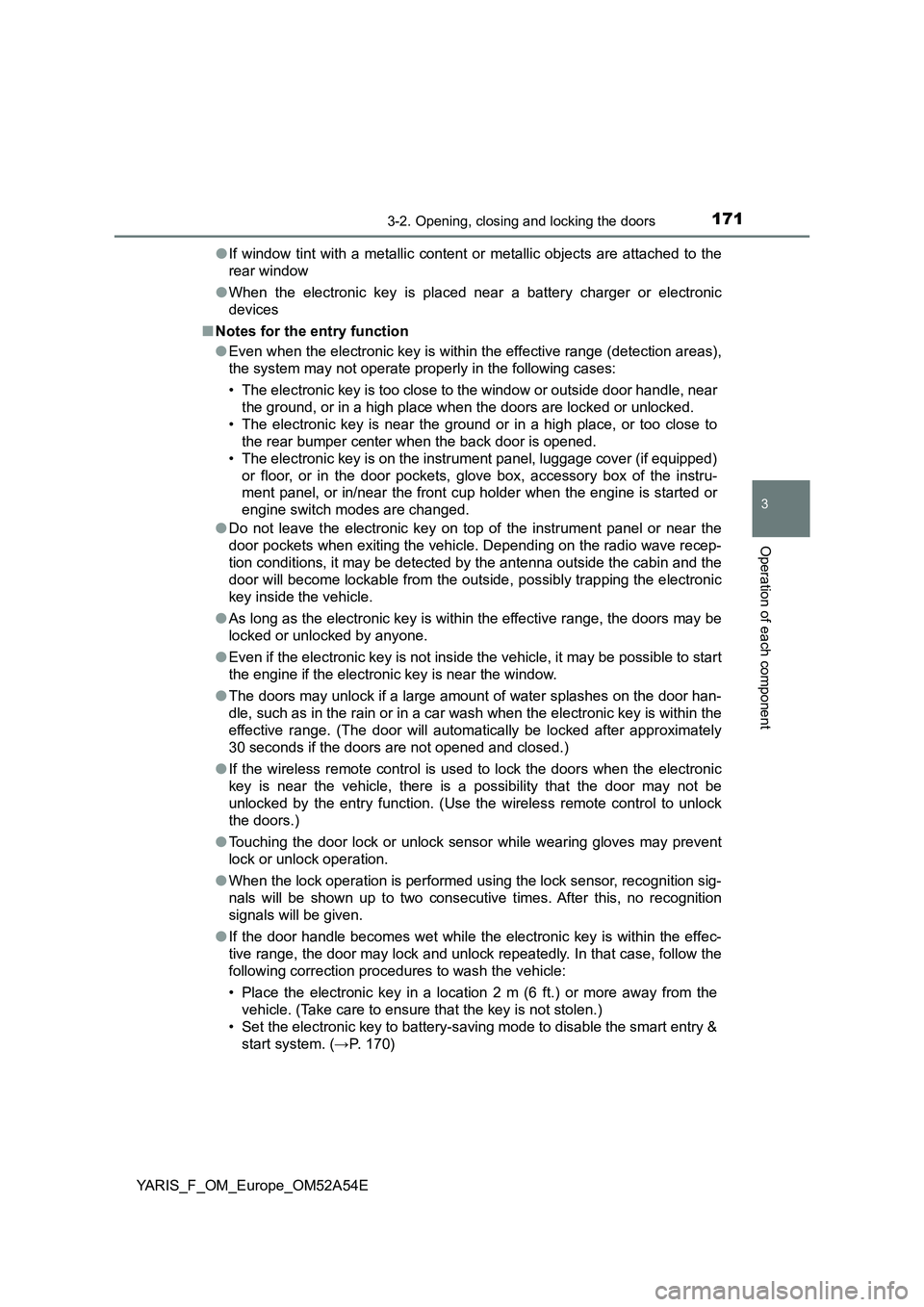
1713-2. Opening, closing and locking the doors
3
Operation of each component
YARIS_F_OM_Europe_OM52A54E●If window tint with a metallic content or metallic objects are attached to the
rear window
●When the electronic key is placed near a battery charger or electronic
devices
■Notes for the entry function
●Even when the electronic key is within the effective range (detection areas),
the system may not operate properly in the following cases:
• The electronic key is too close to the window or outside door handle, near
the ground, or in a high place when the doors are locked or unlocked.
• The electronic key is near the ground or in a high place, or too close to
the rear bumper center when the back door is opened.
• The electronic key is on the instrument panel, luggage cover (if equipped)
or floor, or in the door pockets, glove box, accessory box of the instru-
ment panel, or in/near the front cup holder when the engine is started or
engine switch modes are changed.
●Do not leave the electronic key on top of the instrument panel or near the
door pockets when exiting the vehicle. Depending on the radio wave recep-
tion conditions, it may be detected by the antenna outside the cabin and the
door will become lockable from the outside, possibly trapping the electronic
key inside the vehicle.
●As long as the electronic key is within the effective range, the doors may be
locked or unlocked by anyone.
●Even if the electronic key is not inside the vehicle, it may be possible to start
the engine if the electronic key is near the window.
●The doors may unlock if a large amount of water splashes on the door han-
dle, such as in the rain or in a car wash when the electronic key is within the
effective range. (The door will automatically be locked after approximately
30 seconds if the doors are not opened and closed.)
●If the wireless remote control is used to lock the doors when the electronic
key is near the vehicle, there is a possibility that the door may not be
unlocked by the entry function. (Use the wireless remote control to unlock
the doors.)
●Touching the door lock or unlock sensor while wearing gloves may prevent
lock or unlock operation.
●When the lock operation is performed using the lock sensor, recognition sig-
nals will be shown up to two consecutive times. After this, no recognition
signals will be given.
●If the door handle becomes wet while the electronic key is within the effec-
tive range, the door may lock and unlock repeatedly. In that case, follow the
following correction procedures to wash the vehicle:
• Place the electronic key in a location 2 m (6 ft.) or more away from the
vehicle. (Take care to ensure that the key is not stolen.)
• Set the electronic key to battery-saving mode to disable the smart entry &
start system. (→P. 170)
Page 227 of 692
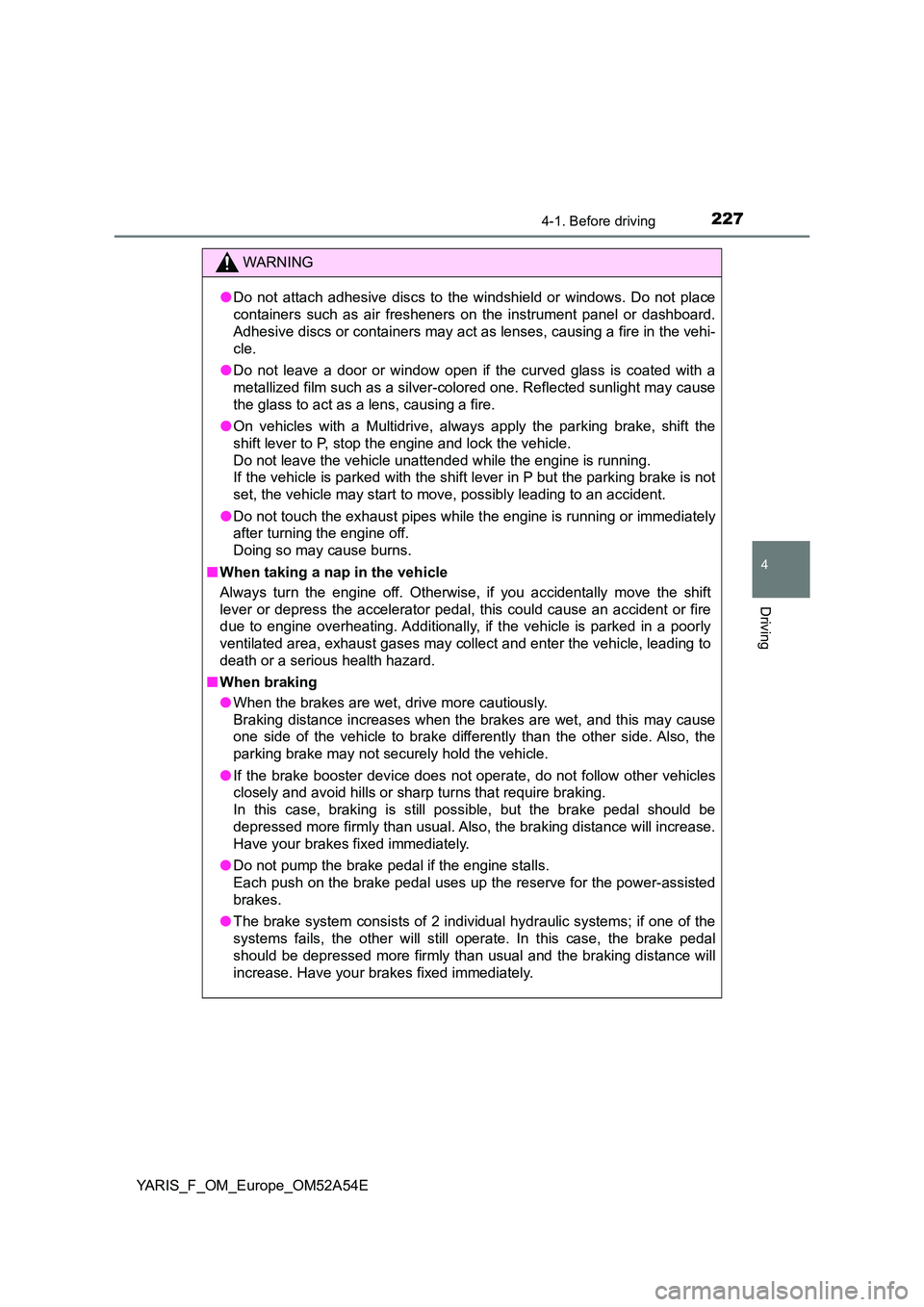
2274-1. Before driving
4
Driving
YARIS_F_OM_Europe_OM52A54E
WARNING
●Do not attach adhesive discs to the windshield or windows. Do not place
containers such as air fresheners on the instrument panel or dashboard.
Adhesive discs or containers may act as lenses, causing a fire in the vehi-
cle.
● Do not leave a door or window open if the curved glass is coated with a
metallized film such as a silver-colored one. Reflected sunlight may cause
the glass to act as a lens, causing a fire.
● On vehicles with a Multidrive, always apply the parking brake, shift the
shift lever to P, stop the engine and lock the vehicle.
Do not leave the vehicle unattended while the engine is running.
If the vehicle is parked with the shift lever in P but the parking brake is not
set, the vehicle may start to move, possibly leading to an accident.
● Do not touch the exhaust pipes while the engine is running or immediately
after turning the engine off.
Doing so may cause burns.
■ When taking a nap in the vehicle
Always turn the engine off. Otherwise, if you accidentally move the shift
lever or depress the accelerator pedal, this could cause an accident or fire
due to engine overheating. Additionally, if the vehicle is parked in a poorly
ventilated area, exhaust gases may collect and enter the vehicle, leading to
death or a serious health hazard.
■ When braking
● When the brakes are wet, drive more cautiously.
Braking distance increases when the brakes are wet, and this may cause
one side of the vehicle to brake differently than the other side. Also, the
parking brake may not securely hold the vehicle.
● If the brake booster device does not operate, do not follow other vehicles
closely and avoid hills or sharp turns that require braking.
In this case, braking is still possible, but the brake pedal should be
depressed more firmly than usual. Also, the braking distance will increase.
Have your brakes fixed immediately.
● Do not pump the brake pedal if the engine stalls.
Each push on the brake pedal uses up the reserve for the power-assisted
brakes.
● The brake system consists of 2 individual hydraulic systems; if one of the
systems fails, the other will still operate. In this case, the brake pedal
should be depressed more firmly than usual and the braking distance will
increase. Have your brakes fixed immediately.